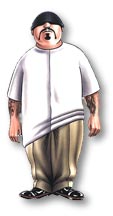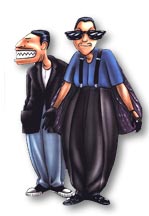
|
Homies PVC Figurines Causing A Stir Again
|
 Deep in San Francisco's largely Hispanic Mission District, a streetwise 16-year-old with braids down her back reclines against a freezer at a local market. Deep in San Francisco's largely Hispanic Mission District, a streetwise 16-year-old with braids down her back reclines against a freezer at a local market.``Yeah, I know about the Homies toys,'' Ashlyn Kalahele says, referring to the wildly popular 50-cent figurines of Latino characters from the street. ``I know a lot of gangsters who collect them. But you have to admit they are kind of cute.'' Reactions like hers are typical and troubling for Homies creator David Gonzales, whose success with the little toys has been bittersweet. With more than four million sold in 1999 alone, they're clearly reaching mainstream audiences.  Gonzales is now developing a cartoon based on the characters that is reminiscent of Bill Cosby's ``Fat Albert,'' whose loopy, streetwise black characters caused a stir during the 1970s. He's got record deals and international markets in his sights, and he plans to expand from six to 54 Homies characters by the end of the year. Gonzales is now developing a cartoon based on the characters that is reminiscent of Bill Cosby's ``Fat Albert,'' whose loopy, streetwise black characters caused a stir during the 1970s. He's got record deals and international markets in his sights, and he plans to expand from six to 54 Homies characters by the end of the year.
But some Latino leaders say the Homies are letting down their culture by perpetuating gang stereotypes with their baggy clothing and names like ``Big Loco'' and ``Eight Ball.'' One culture watcher, however, says the popularity of the toys is a positive reflection of a powerful new demographic - Latinos whose buying power is almost triple what it was 20 years ago, approaching $400 billion a year. ``It's a culture that is neither Latin American nor Anglo but a new group of kids that is the product of many cultures,'' says Felipe Korzenny, a researcher who specializes in marketing to ethnic audiences. ``Things like these toys ... have been repressed in the past but now people are accepting the reality that Hispanics are becoming a force in the U.S.,'' Korzenny says. But for people who deal with gangs on an everyday basis, the Homies are less a fascinating look at culture than another force pushing kids in the wrong direction.  Los Angeles police detective P.J. Morris first learned about the toys while working the anti-gang detail in the San Fernando Valley. He bought some for his own children, but when he heard their reaction, his law-enforcement side kicked in. Los Angeles police detective P.J. Morris first learned about the toys while working the anti-gang detail in the San Fernando Valley. He bought some for his own children, but when he heard their reaction, his law-enforcement side kicked in.
``My kids started saying, `Oh cool, me and my Homies are going to go do a drive-by in the lowrider,''' Morris says. ``They were talking gang talk.'' Morris, who has spoken out against the Homies toys, saying they glorify gangs, and whose comments have spurred several Southern California grocery stores to stop selling them, says he has nothing against Gonzales or the toys themselves. ``But when they're available to youngsters at a gumball machine in a family atmosphere, that's not right,'' he said. ``Anytime you glorify gang images, it changes kids' attitudes toward them. And we don't need that.'' Helen Hernandez, director of the Imagen Foundation, a Southern California nonprofit that encourages positive portrayals of Latinos in film and television, said toys like the Homies perpetuate negative stereotypes. ``With the tattoos and the girls with big hair and short skirts - they don't lend themselves to a positive self-image for our children,'' Hernandez said. Gonzales says he's been misunderstood, and is refusing to give more interviews, even though he admits recent media coverage has significantly boosted his sales. He insisted that the Homies were not meant to look like gang members, and simply reflected the life he grew up with. ``Not all Latinos look like Ricky Martin or Jennifer Lopez,'' he told the San Jose Mercury News. ``There's hundreds of thousands of kids who look like my toys.'' But with his critics in mind, Gonzales has launched a new line of figurines that could be characterized as Homies-lite. They're called ``Mijos,'' slang for ``my sons,'' and they have innocuous names like ``Cry Baby.'' Two million Mijos toys have already been sold, and Gonzales, judging from comments on his Web page, is optimistic that as his work reaches a larger audience, it will be something Latinos can point to with pride. ``We hope to break through the racial stereotypes existing toward the Latino community and the cultural lifestyles of its people, both young and old,'' he says. ``We want the viewers to get to know us as we know ourselves, laugh with us, cruise with us, party with us and share our culture. Maybe then they will not be so intimidated by our appearances and growing numbers. Hopefully they will learn to like us and accept our lifestyle. Maybe then we can call them Homies.'' Source: Jessie Seyfer, Associated Press [Posted 5/22/2000]
  
|









